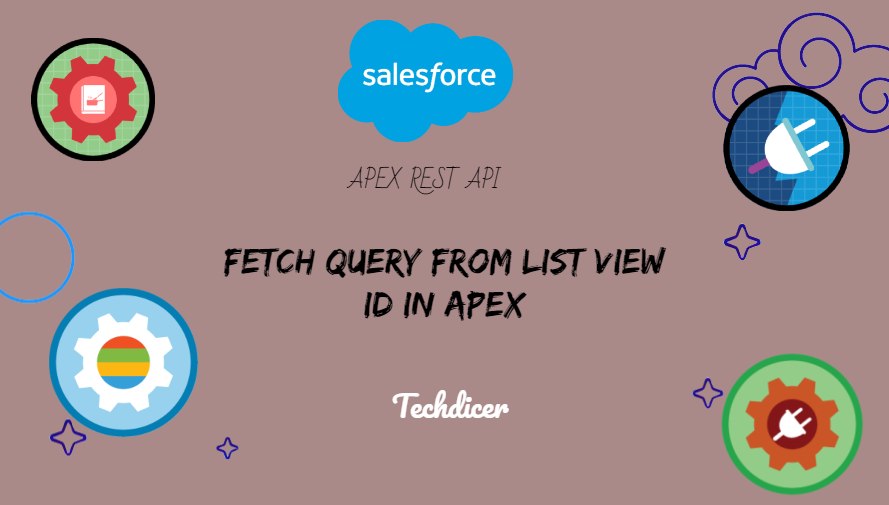Hello friends, today we are going to discuss Fetch Records By LIST VIEW Id In Apex. A LIST view is essentially a filtered and organized representation of data in a Salesforce object. It allows users to define a set of criteria and sorting options to display only the records that meet those criteria. LIST views are commonly used to provide users with a focused and customizable view of data.
One common task in Apex development is retrieving records from a Salesforce object based on specific criteria. While SOQL (Salesforce Object Query Language) is commonly used for querying data, there’s an often overlooked approach that can simplify the process – fetching query results by using a LIST view ID.
Also, check this: Invoke Tooling API From LWC Salesforce
Key Highlights :
- We use Tooling API to fetch query of any LIST view Id and then execute.
- Tooling API allows developers to dynamically query metadata information using SOQL.
- We can call Tooling API by REST API in APEX.
- Use Userinfo.GetSessionId for Authorization.
Code :
ListViewsResponse.cls :
/**
* @description : This class represents the response recieved from the List View APIs which the Salesforce offers.
* @coverage : Test.cls | @CC100%
* @author : techdicerkeeplearning@gmail.com
* @group : Techdicer
* @last modified on : 05-27-2023
* @last modified by : techdicerkeeplearning@gmail.com
* Modifications Log
* Ver Date Author Modification
* 1.0 05-27-2023 techdicerkeeplearning@gmail.com Initial Version | Story Number | @CC100%
**/
public class ListViewsResponse {
public Boolean done;
public List<ListView> listviews;
public Object nextRecordsUrl;
public Integer size;
public String sobjectType;
public class ListView {
public String describeUrl;
public String developerName;
public String id;
public String label;
public String resultsUrl;
public Boolean soqlCompatible;
public String url;
}
public static ListViewsResponse parse( String json ) {
return ( ListViewsResponse ) System.JSON.deserialize( json, ListViewsResponse.class );
}
}
ListViewsDescribeResponse.cls :
public class ListViewsDescribeResponse {
public class OrderBy {
public String fieldNameOrPath;
public String nullsPosition;
public String sortDirection;
}
public List<Columns> columns;
public String id;
public List<OrderBy> orderBy;
public String query;
public String scope;
public String sobjectType;
public WhereCondition whereCondition;
public class Columns {
public String ascendingLabel;
public String descendingLabel;
public String fieldNameOrPath;
public Boolean hidden;
public String label;
public String selectListItem;
public String sortDirection;
public Integer sortIndex;
public Boolean sortable;
public String type;
}
public class WhereCondition {
public List<Conditions> conditions;
public String conjunction;
}
public class Conditions {
}
public static ListViewsDescribeResponse parse(String json) {
return (ListViewsDescribeResponse) System.JSON.deserialize(json, ListViewsDescribeResponse.class);
}
}
ListViewAPI.cls :
/**
* @description : This class is created to make calls to List View APIs which Salesforce offers to get the List View details of a particular object.
* @coverage : Test.cls | @CC100%
* @author : techdicerkeeplearning@gmail.com
* @group : Techdicer
* @last modified on : 05-27-2023
* @last modified by : techdicerkeeplearning@gmail.com
* Modifications Log
* Ver Date Author Modification
* 1.0 05-27-2023 techdicerkeeplearning@gmail.com Initial Version | Story Number | @CC100%
**/
public class ListViewAPI {
/**
* @description This method is created to call the getListViewQuery method fetch query and query the data
* @author techdicerkeeplearning@gmail.com | 05-27-2023 | Story Number
**/
public static void fetchDataAccordingListView(){
String query = getListViewQuery('00B6F00000BMrbT', 'Contact');
List<Sobject> SObjectList = Database.query(query);
System.debug('SObjectList==> ' + SObjectList);
}
/**
* @description This method is created to make request to the List View APIs with the object name to get the List Views in that object.
* @author techdicerkeeplearning@gmail.com | 05-27-2023 | Story Number
* @param sObjectName The name of the Object whose List Views are required.
* @param ListViewsResponse Returns an instance of the 'ListViewsResponse' class which contains the List Views existing in the selected Object.
* @return ListViewsResponse
**/
public static ListViewsResponse getListViews(String sObjectName) {
Http http = new Http();
HttpRequest httpReq = new HttpRequest();
String orgDomain = Url.getSalesforceBaseUrl().toExternalForm();
String endpoint = orgDomain + '/services/data/v37.0/sobjects/' + sObjectName + '/listviews';
httpReq.setEndpoint(endpoint);
httpReq.setMethod('GET');
httpReq.setHeader('Content-Type', 'application/json; charset=UTF-8');
httpReq.setHeader('Accept', 'application/json');
String sessionId = 'Bearer ' + UserInfo.getSessionId();
httpReq.setHeader('Authorization', sessionId);
HttpResponse httpRes = http.send(httpReq);
ListViewsResponse listViewResp = (ListViewsResponse) JSON.deserialize( httpRes.getBody(), ListViewsResponse.class);
return listViewResp;
}
/**
* @description This method is created to get the Query to obtain records from a particular object
* @author techdicerkeeplearning@gmail.com | 05-27-2023 | Story Number
* @param listViewId Recieves the List View Id whichever the User wants.
* @param objName The name of the SObject.
* @return String Returns the query for the particular List View.
**/
public static String getListViewQuery(String listViewId, String objName) {
Http http = new Http();
HTTPRequest httpReq = new HTTPRequest();
String orgDomain = Url.getSalesforceBaseUrl().toExternalForm();
String endpoint = orgDomain + '/services/data/v37.0/sobjects/' + objName + '/listviews/' + listViewId + '/describe';
httpReq.setEndpoint( endpoint );
httpReq.setMethod( 'GET' );
httpReq.setHeader( 'Content-Type', 'application/json; charset=UTF-8' );
httpReq.setHeader( 'Accept', 'application/json' );
String sessionId = 'Bearer ' + UserInfo.getSessionId();
httpReq.setHeader( 'Authorization', sessionId );
HTTPResponse httpRes = http.send(httpReq);
System.debug(httpRes.getBody());
if(httpRes.getStatusCode() == 200){
ListViewsDescribeResponse listViewDescResp = (ListViewsDescribeResponse) JSON.deserialize(httpRes.getBody(), ListViewsDescribeResponse.class);
return listViewDescResp.query;
} else{
return '';
}
}
}


2 comments
I called method fetchDataAccordingListView( i.e. getListViewQuery) from the Aura init method and it gave me 401 status code. Session Id authentication not working as expected
Hi @SM, by Aura component you can not use UserInfo.getSessionId()
You can create VF page and get session Id in apex. you can take reference from below blog
https://techdicer.com/invoke-tooling-api-from-lwc-salesforce/